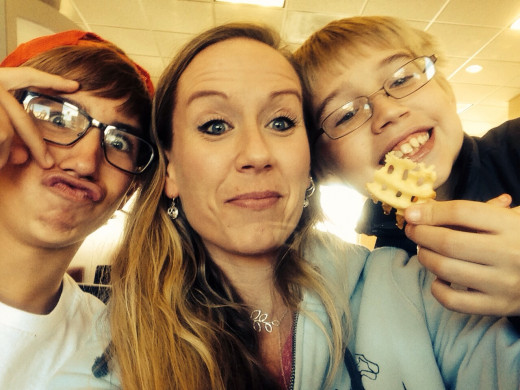Characteristics of Resilience


Definition of Resilience
Resilience is the ability to maintain a stable frame of mind during situations which are disruptive to your well being. People who are resilient are mentally strong and emotionally stable. Not only can they adapt easily to change but they can also make it work to their advantage.
Resilient children are confident and possess self esteem, they are socially interactive, able to solve problems and can react appropriately to adversity or hardships.
While experts don't necessarily agree on the exact definition of resilience, they do agree that people are not born with a resilient trait but rather that it is a continuous process that begins with parenting and continues through schools, communities, churches, social interactions and social factors. It is the constant development of productive coping mechanisms that evolve within children, adolescents, teens and adults.
Resilience is also a method of recovery from trauma, danger or severe distress. People who are exposed to caustic situations may experience immediate and negative physiological symptoms but will recover over a period of time. The biggest risk factors for trauma recovery are: age at the time of the incident and whether or not the individual has strong family support.
Which of the following has the most influence on a child's resilience?
The Science Behind Resilience
Since the development of resilience is an ongoing process, it is important to recognize that in different populations there will be different strengths and weaknesses which are indicative of the entire group, no matter what types of difficulties they face. In difficult situations, resources work in different ways. Children who live in poverty and do not have access to good schools would benefit tremendously from a more abundant lifestyle and better schooling. The same is not true for a child who comes from a wealthy home and a private school.
Resilience can be understood two-dimensionally. It is based on the amount of distress to the individual and their positive adjustment. Risk factors include any situations which would cause duress or prevent appropriate adjustment to the individual. Experts agree that family, cultural and social factors play a critical role in the development of resilience among youth who are considered "at-risk."



Components of Resilience
- Strong family bonds
- Understand perspective and keep issues in proper context
- Accept situations that cannot change
- Develop self esteem and confidence
- Take care of the mind, body and soul
- Discover opportunities in both positive and negative settings
- Set and attain goals
- Able to handle stress
- Make good decisions in difficult situations
- Maintain a sense of hope and expectation
Building Resilient Kids
When children are born parents often jest about how great it would be if kids came with a handbook. Since they don't, it's completely up to the parents to jump start healthy, happy children who will be able to make their way in the world as productive citizens.
Every child is unique; learning in different ways and at a different paces. Since there is not a proven methodology for raising the ideal resilient child, there is a useful guide which can be applied to all children.
Blueprint For Success: Resilient Kids
- Validate and empathize: When your kiddo is trying to express their point of view, it's important that you attempt to understand their perspective. If you empathize with how they are feeling and you let them know that you understand, it will help build mutual respect and trust.
- Teach in the moment: If you have repeatedly asked your child to do something that has repeatedly not been done, instead of using your stock response, try using some fresh tactics. Change the way you are teaching. Negative reinforcement hasn't been a successful means of behavior modification since the dark ages so teach your kiddo with benevolence and love.
- Love unconditionally: It's crucial that children have a strong bond with a parent, guardian or an adult that makes them feel safe and appreciated. Kids blossom in atmosphere where they are praised for their strengths and accepted without judgement. Kids love to be loved.
- Be a good communicator and a great listener: When your kiddo is talking about something important - including things that are important to them, use your active listening skills. Look them in the eyes. Respond to what they are saying. Engage them in more conversation by asking questions and don't interrupt while they have "the floor."
- Teach your children to pay-it-forward: Having a connection to the greater good is important because it establishes a connection between kids, peers and the community. Acts of kindness are wonderful for a child's self confidence.
- Provide discipline that is appropriate and justified: The two things you should always remember when you are handing down the verdict is: be consistent and keep the situation in proper perspective. It's unrealistic to be grounded for 105 days because the bicycles were left out in the driveway overnight, but it is realistic to do the dinner dishes and lose bicycle privileges for a week.
- Work with your kids to set goals and how to recover when mistakes are made: Goal setting is important because when a child successfully attains a goal, they feel a sense of accomplishment. However small that triumph may be, it is a win and it should be celebrated. When a child makes a mistake, use the occasion to teach them that it's an opportunity to learn and grow as opposed to being a moment of failure.
- Help your kids learn how to make good choices and to be problem solvers: When kids come across difficult situations they need guidance to learn how to make good choices. Teaching children to see causal relationships and to consider the consequence of their actions is essential for kids to learn. Discussing many different outcomes and solutions with your kiddo will help them understand the importance of making logical, rational and appropriate choices.
Resilience Among Cultures
CHARACTERISTIC
| EXAMPLES
|
|---|---|
Resources
| money, education, employment, medical assistance and basic necessities
|
Supportive relationships
| parents, siblings, relatives and peers
|
Personal identity
| having a sense of purpose, hope, goals, values and spiritual identity
|
Personal strength
| taking care of one's own personal needs
|
Cultural identity
| understanding and practicing cultural practices and traditions
|
Social equality and justice
| having a purposeful role in the community
|
Alignment with peers
| finding balance between interest and responsibility to contributing to society
|
Other Great Hubs
- 28 Easy Ways to Make Your Children Feel Special
There are numerous ways to let your kiddo know how wonderful and special they are. This is a detailed list of ideas you can use when you're interacting with your child. Also included is a list of 50 praise phrases! - Misinterpretation: Silence is Not Consent
Communication can be difficult due to misinterpretation. There are many reasons people misinterpret their interactions and conversations. Read about the ways reality gets distorted and how you can avoid conflict in the future. - 10 Ways to Stop Being the Drama Queen at Work!
This hub will help you identify whether or not you might have a drama queen at work. It will also help you avoid becoming the drama queen! - How to Keep Professionalism at Work
Manager's can be the bridge between an employee's success or failure at any given job. Use these ideas to be a better manager with a consistently happy and productive team.





